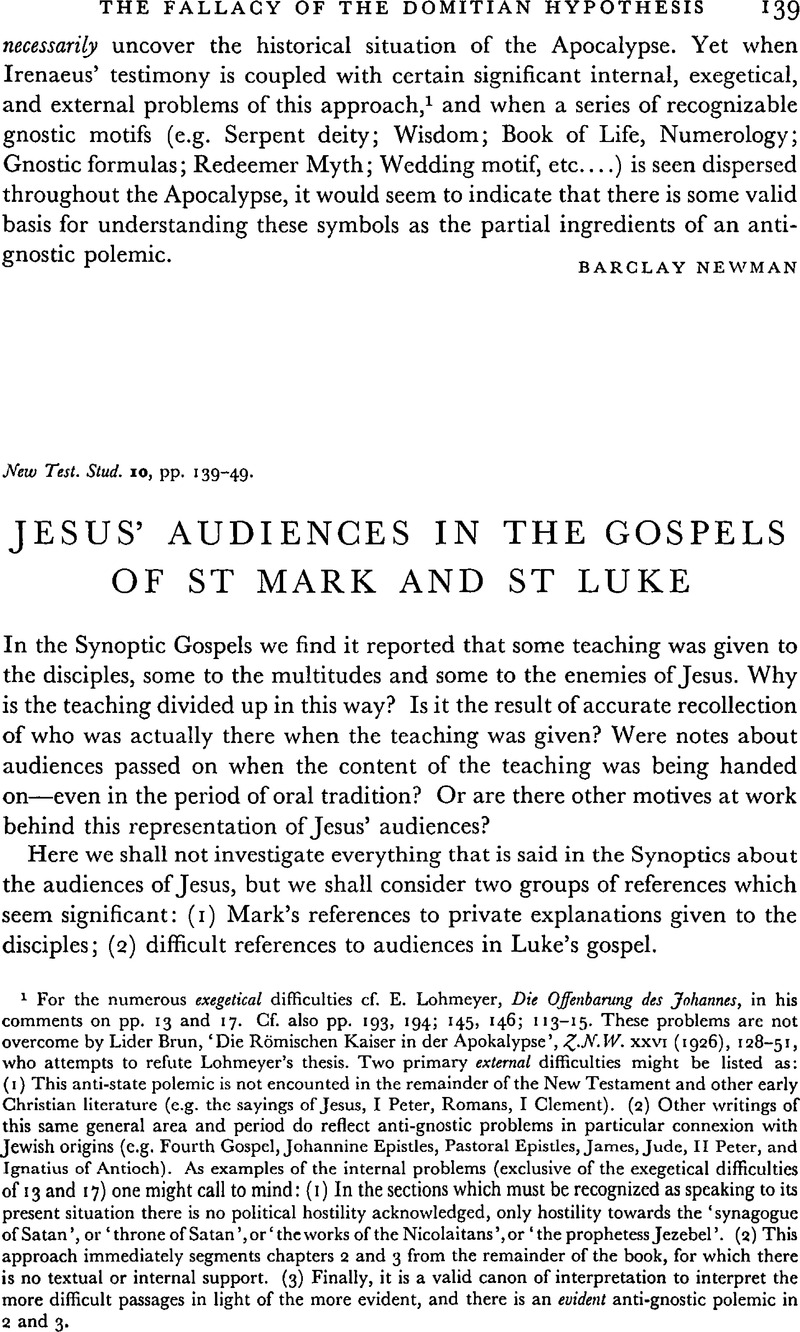Published online by Cambridge University Press: 05 February 2009

page 139 note 1 For the numerous exegetical difficulties cf. E. Lohmeyer, Die Offenbarung des Johannes, in his comments on pp. 13 and 17. Cf. also pp. 193, 194; 145, 146; 113–15. These problems are not overcome by Lider Brun, ‘Die Römischen Kaiser in der Apokalypse’, Z.N.W. xxvi (1926), 128–51, who attempts to refute Lohmeyer's thesis. Two primary external difficulties might be listed as: (1) This anti-state polemic is not encounted in the remainder of the New Testament and other early Christian literature (e.g. the sayings of Jesus, I Peter, Romans, I Clement). (2) Other writings of this same general area and period do reflect anti-gnostic problems in particular connexion with Jewish origins (e.g. Fourth Gospel, Johannine Epistles, Pastoral Epistles, James, Jude, II Peter, and Ignatius of Antioch). As examples of the internal problems (exclusive of the exegetical difficulties of 13 and 17) one might call to mind: (I) In the sections which must be recognized as speaking to its present situation there is no political hostility acknowledged, only hostility towards the ‘synagogue of Satan’, or ‘throne of Satan’, or ‘the works of the Nicolaitans’, or ‘the prophetess Jezebel’. (2) This approach immediately segments chapters 2 and 3 from the remainder of the book, for which there is no textual or internal support. (3) Finally, it is a valid canon of interpretation to interpret the more difficult passages in light of the more evident, and there is an evident anti-gnostic polemic in 2 and 3.
page 140 note 1 Scott, E. F., Validity of the Gospel Record, p. 183.Google Scholar
page 141 note 1 Gospel according to St Mark, Taylor, pp. 46 f.Google Scholar
page 141 note 2 Ibid.ad loc.
page 141 note 3 Ibid.ad loc.
page 141 note 4 Ibid. on Mark ii. i.
page 141 note 5 Ibid. on Mark ii. 27.
page 141 note 6 Ibid.ad loc.
page 141 note 7 Parables of Jesus, p. 12 n. II.
page 141 note 8 Gospel according to St Mark, p. 85.Google Scholar
page 141 note 9 Ibid. on Mark v. 9.
page 142 note 1 Teaching of Jesus, pp. 76–9.
page 142 note 2 Parables of Jesus, p. 15.
page 142 note 3 Gospel according to St Mark, ad loc.Google Scholar
page 142 note 4 Ibid. pp. 344, 345.
page 142 note 5 Gospel according to St Mark, ad loc.
page 142 note 6 Kingdom of God and Son of Man, p. 249.
page 142 note 7 Gospel according to St Mark, ad loc.
page 142 note 8 Sayings of Jesus, p. 137.
page 143 note 1 Teaching of Jesus, pp. 18f.
page 143 note 2 Gospel according to St Luke, p. 170.
page 144 note 1 Dodd, Parables of the Kingdom, p. 144; Otto, Kingdom of God and Son of Man, p. 149; T. W. Manson, Sayings of Jesus, p. 106; Jeremias, Parables of Jesus, p. 153 n. 71.
page 144 note 2 Gospel according to St Mark, p. 47.Google Scholar
page 144 note 3 Ibid. p. 257.
page 144 note 4 New Testament Doctrine of the Christ, p. 260.
page 144 note 5 Sayings of Jesus, p. 78.
page 144 note 6 Parables, p. 42 n. 2.
page 144 note 7 Gospel according to St Matthew, on Matt. xi. 25.
page 146 note 1 Parables of Jesus, p. 77 n. 66.
page 146 note 2 See also Lightfoot, History and Interpretation in the Gospels, pp. 221f.
page 147 note 1 Geschichte der Synoptischen Tradition, pp. 388 f.Google Scholar
page 147 note 2 Ibid. p. 390.
page 147 note 3 Ibid. p. 358.
page 147 note 4 Sayings of Jesus, p. III.Google Scholar
page 147 note 5 Ibid. p. 121.
page 147 note 6 Streeter, The Four Gospels, p. 287.
page 147 note 7 Hawkins, , Horae Synopticae, p. 36.Google Scholar
page 147 note 8 Ibid. p. 30.
page 147 note 9 Ibid. p. 32.
page 147 note 10 Ibid. p. 31.
page 148 note 1 Sayings of Jesus, p. 80.Google Scholar
page 148 note 2 Ibid. p. 270.
page 148 note 3 See (b), p. 146 above.
page 149 note 1 Teaching of Jesus, pp. 17f.
page 149 note 2 Parables of Jesus, pp. 23ff.